5 Deadliest Animals In Nevada That Will Take Your Breath Away
Nevada, known for its expansive deserts and breathtaking landscapes, is home to a variety of deadly animals. The most dangerous creatures in Nevada can end up becoming the main characters of your worst nightmares.
Pretty exciting, right?
While encounters with these creatures are relatively rare, it’s essential to be aware of their presence and take the necessary precautions when exploring the wilderness.
Let’s initiate the journey and discover more about the deadliest wildlife in Nevada.
5 Animals in Nevada With A Death Association
1. Spiders

You might be surprised to learn that Las Vegas is famous not only for its wealth of nightlife but also for its venomous spiders. Yes, believe it or not, adrenaline seekers in Las Vegas might have more to fear from spider bites than losing at the poker table while gambling at vibrant casinos across the state of Nevada.
However, you should know that the Black Widow and the Brown Recluse are two spiders in Nevada that should be avoided. Black widows have a vivid red hourglass sign on the bottom of their abdomen and are glossy black. They use a substance called alpha-latrotoxin in their venom, which is about 15 times more powerful than rattlesnake venom and overwhelms nerve cells, resulting in horrific pain.
The poison from a brown recluse is particularly lethal. It breaks down blood vessels, skin, and fat when injected via a bite. Cell membranes are also destroyed. In the end, this results in the death of the nearby afflicted tissue. Thankfully, the majority of Brown Recluse bites are mild and cause minor harm to the tissue. The venom makes the area red, swollen, and sensitive; however, symptoms diminish on their own in 3 weeks without the need for medical attention.
2. Rattlesnakes

Nevada is home to 5 different venomous snake species, all of which are pit vipers. They include the Mohave, Speckled, Sidewinder, Great Basin, and Western Diamondback rattlesnakes. As pit vipers, they have a tiny “pit” under each eye that acts as a sensory organ to detect prey. Additionally, each of them has a rattle that they use to warn onlookers. Rattlesnakes’ teeth, which can inflict a severe bite and release venom, are their most hazardous characteristic.
Rattlesnake bites occur in about 50% of cases as “dry bites,” meaning the snake did not inject any venom. If the snake injected the poison and your heart was beating rapidly, the venom would simply be pumped into your system more quickly. But still, despite 7000 and 8000 poisonous snake bites being reported annually in the United States, only an average of 5 of those bites result in death.
3. Scorpions

Southern Nevada is home to the most venomous scorpion in North America, the bark scorpion. The majority of scorpion species live alone, whereas bark scorpions form “gatherings” to live together. It is fairly typical for groups of 20-30 bark scorpions to be found together.
Based on the reports, it has been noted that scorpions are considered to be one of the deadliest animals for humans. The reason is that they cause approximately 3,250 deaths each year. Keep in mind that although scorpions are not known for biting, their sting can still be deadly.
All scorpion stings result in pain, tingling, and numbness at the sting location. Pain strikes immediately. For the first 2 hours, the pain may be exceptionally severe. Within the following 24 hours, symptoms near the site began to decrease.
A further observation is that at night, bark scorpions appear to shine. You can find the blue-green light that these animals release by going out into the desert at night and shining a UV light.
4. Assassin Bugs

With a broad body, a short head, and huge eyes on either side, assassin bugs can grow to be 1.5 inches long. Their most distinctive characteristic is a claw-like beak that they utilize to bite into prey to suck their blood. They are ironically sometimes referred to as “Kissing Bugs.” They were known by this nickname because it appeared that they mainly bit victims’ faces and mouths. Assassin bugs’ bites are terrible.
Some assassin bug species can carry a parasite that causes Chagas Disease through their feces, which may be asymptomatic in some individuals but can eventually cause fever and vomiting as well as heart problems in others.
5. The Gila Monster

Considering it is the only venomous lizard in Nevada, the Gila Monster presents a threat. Its poison is roughly equivalent to that of a western diamondback rattlesnake. The bite from a Gila monster can cause swelling, severe searing pain, vomiting, dizziness, weakness, a rapid heartbeat, and/or low blood pressure, though it is rarely life-threatening.
The appearance of Gila Monsters is particularly distinctive because of their black bodies that resemble they are covered in beads and their banded pattern of dots and stripes that are pinkish-orange in color. Being up to 22 inches long, they are quite big reptiles.
Bottom Line
As you can see, there are plenty of creatures throughout Nevada that are extremely hazardous and whose bites cause severe discomfort. However, for wildlife enthusiasts who crave adventure and are fascinated by these creatures, there is still much to learn and discover. By exploring our informative database, you can gain valuable knowledge about these animals and how to stay safe in their natural habitat.

Nato is a content writer and researcher with a background in psychology who’s eager to explore the wonders of nature. As a travel enthusiast and animal lover, she hopes to inspire others to discover and cherish the beauty and importance of the natural world.







